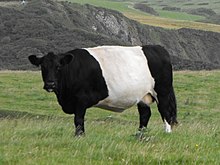|
Lakenvelder cattle
 The Lakenvelder is a Dutch and German breed of dairy cattle. It is reported from the Netherlands and Belgium, but may be extinct in Germany.[2][5][6] HistoryNo written evidence supports an often-repeated claim that the Lakenvelder derives from cattle of the Gurtenvieh or belted Braunvieh of Switzerland, brought to the Netherlands in or after Mediaeval times by the nobility or the wealthy.[7]: 176 It is however supported by molecular genetic studies, which have shown that the Gurtenvieh, the Lakenvelder and the Belted Galloway all carry the same candidate gene for the belted phenotype.[4]: 224 [8]: 304 Cattle with this characteristic are shown in Dutch paintings from the seventeenth century.[8]: 304 It seems likely that the Lakenvelder derives directly from Swiss and Austrian belted cattle, and that during the reign of William of Orange some cattle of this type found their way to Scotland, where they inter-bred with Galloway stock, giving rise to the Belted Galloway.[8]: 304 A herd-book for the Lakenvelder was started in 1918; at that time there were about fifteen farms breeding the cattle, with some 200 head between them.[4]: 224 In 1930 regulations were introduced to control milk production and to make testing for tuberculosis obligatory; by the end of the Second World War only five herds remained.[9]: 285 CharacteristicsThe Lakenvelder is finely built and of small to medium size, with a withers height in the range 126–136 cm for cows and averaging 133 cm[4]: 225 or 137 cm for bulls.[3]: 97 Body weights are variously reported as 500 kg[4]: 225 or 700 kg for bulls,[3]: 97 and 450 kg[4]: 224 or 550 kg for cows.[3]: 97 The coat may be either black or dusky red, always with a broad belt of white encircling the body behind the shoulder and in front of the hip; black and red animals are in approximately equal numbers.[4]: 225 There are no other white markings on the head or body;[10] the horns, tongue and udder are pigmented.[11] Both sexes normally carry horns, but polled animals can occur.[2] UseIt is a dual-purpose breed, with both dairy and beef strains. Beef yields are not high, but the meat is of good quality and has achieved good results in comparative taste tests.[10][11] The milk is high in protein and low in fat; milk yields are of the order of 5000–6000 kg per year.[3]: 97 ReferencesWikimedia Commons has media related to Lakenvelder cattle.
|
||||||||||||||||||
Portal di Ensiklopedia Dunia
